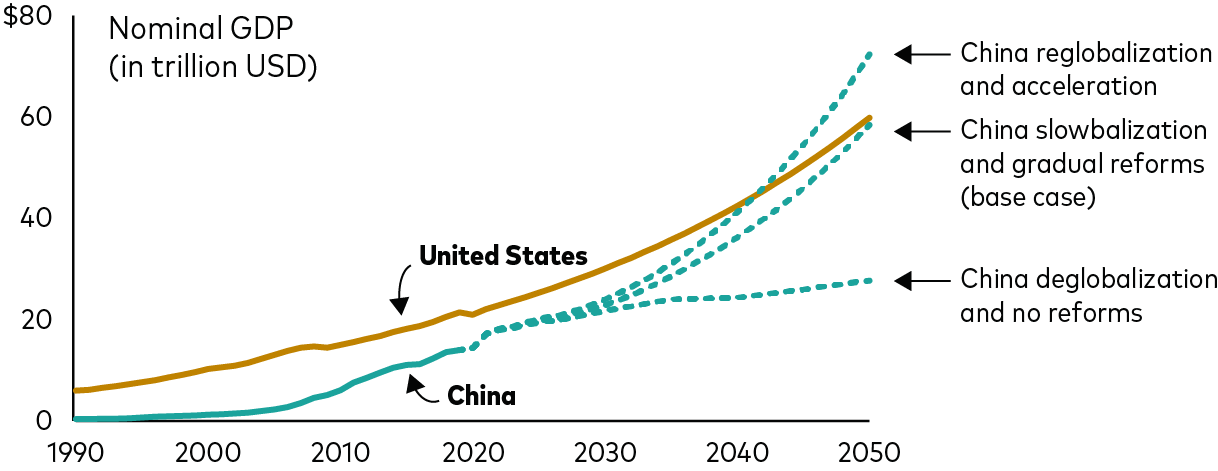A likely China path: Lower but more sustainable growth

Commentary by Qian Wang, Ph.D., Vanguard Asia-Pacific chief economist
China’s economy has grown since the 1990s from being a tenth of the size of the U.S. economy to close to two-thirds the size.1 This raises some natural questions, including, “When might China become the world’s largest economy?” and “What are the potential portfolio implications of such a new economic order?”
Vanguard’s global economics team set out recently to answer these questions and others in the greater context of the world’s productive capacity. We collected the China-specific findings based on our analysis of nearly 150 countries in A Tale of Two Paths: The Future of China. The paper is part of our Megatrends series, which tries to make sense of how long-term shifts in the global economic landscape are likely to affect the financial services industry and broader society.
We found that China’s future as the world’s largest economy is not a foregone conclusion. Whether China manages to tip the balance of economic power or remains stuck in what is known as the middle-income trap will hinge primarily on its ability to navigate rising international and domestic matters. Continued growth for China could mean portfolio diversification benefits for global investors.
How China could become the world’s largest economy
Sources: Vanguard, using data from the World Bank, as of July 2021.
Our analysis establishes our base case that China’s economy will experience lower but more sustainable growth over the long term as it shifts toward domestic consumption and services, enabling it to outstrip that of the United States sometime beyond 2050.
That scenario factors in headwinds from slowing global trade growth, a trend we looked at recently in another paper in our Megatrends series, The Deglobalization Myth(s). It also anticipates a gradual pace of improvements in education quality, domestic innovation, and privatization reforms, and capital flowing more symmetrically with other nations as policymakers balance a desire for growth rate with medium-term considerations of growth quality and financial stability. Growth could be even faster should reforms and globalization accelerate, allowing China to become the world’s largest economy by 2040.
China’s potential economic trajectories are myriad
The pace and extent of progress in these areas, coupled with an evolving external environment, create multiple potential long-term economic trajectories for China. Another potential path is that reforms stall and cross-border trade and investment slow sharply, resulting in China’s falling into the middle-income trap—stagnation resulting from a lack of much-needed reform—and failing to ever outstrip the size of the U.S. economy.
China’s transition from the world’s manufacturer to an innovative, consumer-driven economy would have important, uneven spillover effects on global growth. Neighboring countries such as Japan and South Korea would likely benefit from the rise of a Chinese consumer interested in tourism, luxury goods, and education. On the other hand, raw commodity exporters such as Brazil would be hard-hit by a slowdown in China’s old-economy industries such as steel production and manufacturing.
Our outlook for China depends on the path it chooses
Reforms to China’s capital markets would likely also have implications for globally diversified investors. China currently has the second-largest equity and bond markets in the world, but a combination of GDP growth, international capital openness, and domestic economic reforms could lead to much greater market capitalizations. For a globally diversified investor, that could translate into an allocation to China roughly doubling from 7% to 14% in an equity portfolio and 7% to 12% in a bond portfolio by 2035. Allocations to China come with a potential diversification benefit given its relatively low correlation with other markets.
Whether China avoids the middle-income trap depends on the degree to which it undertakes domestic reforms in two interrelated areas: alleviating structural risks related to financial and labor markets and encouraging technological innovation. Its chosen path will define one of the key global economic narratives of a generation.
Notes:
All investing is subject to risk, including the possible loss of the money you invest. Investments in securities issued by non-U.S. companies and governments are subject to risks including country/regional risk and currency risk. Diversification does not ensure a profit or protect against a loss.
For institutional and sophisticated investors only. Not for public distribution.
Important Information
VIGM, S.A. de C.V. Asesor en Inversiones Independiente (“Vanguard Mexico”) registration number: 30119-001-(14831)-19/09/2018. The registration of Vanguard Mexico before the Comisión Nacional Bancaria y de Valores (“CNBV”) as an Asesor en Inversiones Independiente is not a certification of Vanguard Mexico’s compliance with regulation applicable to Advisory Investment Services (Servicios de Inversión Asesorados) nor a certification on the accuracy of the information provided herein. The supervision scope of the CNBV is limited to Advisory Investment Services only and not to all services provided by Vanguard Mexico.
This material is solely for informational purposes and does not constitute an offer or solicitation to sell or a solicitation of an offer to buy any security, nor shall any such securities be offered or sold to any person, in any jurisdiction in which an offer, solicitation, purchase or sale would be unlawful under the securities law of that jurisdiction. Reliance upon information in this material is at the sole discretion of the reader.
Securities information provided in this document must be reviewed together with the offering information of each of the securities which may be found on Vanguard’s website: https://www.vanguardmexico.com/web/cf/mexicoinstitutional/en/home or www.vanguard.com
Vanguard Mexico may recommend products of The Vanguard Group Inc. and its affiliates and such affiliates and their clients may maintain positions in the securities recommended by Vanguard Mexico.
ETF Shares can be bought and sold only through a broker and cannot be redeemed with the issuing fund other than in very large aggregations. Investing in ETFs entails stockbroker commission and a bid-offer spread which should be considered fully before investing. The market price of ETF Shares may be more or less than net asset value.
All investments are subject to risk, including the possible loss of the money you invest. Investments in bond funds are subject to interest rate, credit, and inflation risk. Governmental backing of securities apply only to the underlying securities and does not prevent share-price fluctuations. High-yield bonds generally have medium- and lower-range credit quality ratings and are therefore subject to a higher level of credit risk than bonds with higher credit quality ratings.
There is no guarantee that any forecasts made will come to pass. Past performance is no guarantee of future results.
Prices of mid- and small-cap stocks often fluctuate more than those of large-company stocks. Funds that concentrate on a relatively narrow market sector face the risk of higher share-price volatility. Stocks of companies are subject to national and regional political and economic risks and to the risk of currency fluctuations, these risks are especially high in emerging markets. Changes in exchange rates may have an adverse effect on the value, price or income of a fund.
The information contained in this material derived from third-party sources is deemed reliable, however Vanguard Mexico and The Vanguard Group Inc. are not responsible and do not guarantee the completeness or accuracy of such information.
This document should not be considered as an investment recommendation, a recommendation can only be provided by Vanguard Mexico upon completion of the relevant profiling and legal processes.
This document is for educational purposes only and does not take into consideration your background and specific circumstances nor any other investment profiling circumstances that could be material for taking an investment decision. We recommend to obtain professional investment advice based on your individual circumstances before taking an investment decision.
These materials are intended for institutional and sophisticated investors use only and not for public distribution.
Materials are provided only for their exclusive use and shall not be distributed to any other individual or entity. Broker-dealers, advisers, and other intermediaries must determine whether their clients are eligible for investment in the products discussed herein.
The information contained herein does not constitute an offer or solicitation and may not be treated as such in any jurisdiction where such an offer or solicitation is against the law, or to anyone for whom it is unlawful to make such an offer or solicitation, or if the person making the offer or solicitation is not qualified to do so.
